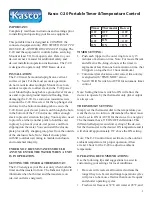
WWW.tmilock.com
Corporate Headquarters
:
127 SE 29
th
St • Topeka, Kansas 66605 • USA Tel. 785-232-8705
●
Fax 785-232-2603
Page | 1
Timetrax Timelock Timing Machines
Instructions
Introduction
Timetrax timing machines were designed for use in calibrating mechanical watches and clocks. There are two basic
parameters that are addressed in calibrating a timelock movement,
beat & rate.
Beat or “in-beat” refers to the accuracy of the
escapement. Rate references the net gain or loss of time over a twenty-four hour period or a single hour. Timetrax is a CMOS
based diagnostic tool that accurately converts a mechanical tick into an electrical impulse. This impulse is expressed in
numeric form on the built in LCD screen and interpreted by the operator. The primary features include direct reading train,
seconds per day, digital balance readout, seconds gained or lost per 24 hours, 40 programmed gear trains and audio
amplification of the movement under study.
Setup
1.
Position the movement to be analyzed on a stable work surface, free of vibration and away from moving air
currents.
2.
Plug in the alligator type clip transducer on the lower left side of the Timetrax machine
3.
Clip the alligator portion to the side of the top plate of the movement to be tested. The best location is normally
the right side, near the escapement.
4.
Slide the on-off switch to the “Beat-Amp” position
5.
Increase “Gain” by rotating the appropriate knob, until the audible beat of the movement is heard. Gain should
not be rotated more than 90° clockwise for this phase of the testing process. The sound a movement makes is the
first indicator of how in-beat the movement actually is. Train your ear to hear the variables.
6.
Slide the “on-off” switch to the “timer” position. 550 will appear in the LCD screen. This is the series of software
contained therein.
7.
Immediately after 550 appears an actual reading of the “Beats Per Hour” will appear. This is the automatic default
each time the machine is turned off. Press the key marked with a + symbol and “Pre- Set Train.” Set the correct
gear train of the movement under test.
8.
Press the key marked with a + symbol and “Pre-Set-Average.” Continue pressing this key until you reach # 30.
This will represent the number of actual beats analyzed before the Timetrax renders a reading. An escape wheel
has 15 teeth, each one giving two (2) impulses for a total of 30 beats per revolution of the entire escape wheel.
The automatic default for the machine is 2.
9.
Press the button marked “Mode.” The first screen will read “BPH” or beats per hour. Press the mode button again.
The next screen will read” SEC.” or second per day. Take your first reading at this site. Adjust the “Rate
Regulator” accordingly, allowing the readings to stabilize with your hands completely removed from the
movement under test. You will come back to this function mode after you adjust “Beat.”
10.
Press the mode key until you reach a screen which will read “BAL.” This is the In-Beat Mode. Make your
adjustments accordingly, remembering to allow all readings to settle down and without your hands near or
touching the movement under test. An accurate “In-Beat” reading will be below .5. If your reading is higher than
1.0, readjust your movement until you achieve an acceptable parameter below 1.0.
11.
If you are having problems reaching a stable reading, an additional noise filter can be used. The built in “Noise”
filter is a variable adjustment called “Hold-off.” Rotate this knob clockwise, while observing the LED blink in-
time with the actual beat of the movement under test. The proper adjustment of Hold- off is where the LED blink
rate corresponds accurately to the actual “ticking” of the movement under test. Too much Hold-off is worse than
not enough. Pay close attention to the LED blink rate during all phases of the testing procedure.
12.
Press the “Mode” key and return to “SEC” and set the movement to the industry standard of 40 seconds fast in 24
hours.




















